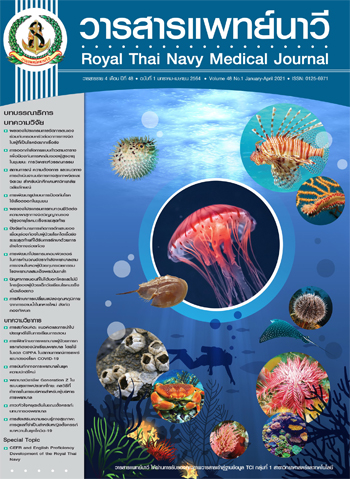The Unspecified and Unrecognized Sleep Problems in School-age Patients with Leukemia
Main Article Content
Abstract
The purpose of this qualitative research is to investigate sleep problems and management of sleep problems among school-age patients with leukemia during chemotherapy. Informants were school-aged leukemia patients between the ages of 8 - 12 years who were admitted to the Queen Sirikit National Institute of Child Health, and they were undergoing chemotherapy for stage II onwards. Data were collected by in-depth interviews until data saturation was achieved by interviewing ten informants. Analyses of the data were carried out in the thematic approach essentially to draw conclusions and interpret them into key themes.
"The unspecified and unknown sleep problems" is one of the main focus areas of this study. These findings also reflect the fact that school-age patients with leukemia are also afflicted with insomnia at home and in the hospital. The results support the notion that school-age patients with leukemia during chemotherapy have unresolved sleep problems, and the results can be used as a basis for the care of this group of patients and future studies on similar issues.
Article Details

This work is licensed under a Creative Commons Attribution-NonCommercial-NoDerivatives 4.0 International License.
References
Redeker N, McEnany GP, editors. Sleep disorders and sleep promotion in nursing practice. New York: Springer Publishing Company; 2011.
Meltzer LJ, Davis KF, Mindell JA. Patient and parent sleep in a children's hospital. Pediatr Nurs 2012;38(2):64-71.
Hysing M, Sivertsen B, Stormark KM, Elgen I, Lundervold AJ. Sleep in children with chronic illness, and the relation to emotional and behavioral problems--a population-based study. J Pediatr Psychol 2009;34(6):665-70.
Kaleyias J, Manley P, Kothare SV. Sleep disorders in children with cancer. Semin Pediatr Neurol 2012;19(1):25-34.
Pui CH. Acute lymphoblastic leukemia in children. Curr Opin Oncol 2000;12(1):3-12.
Get-Kong S, Hanucharurnkul S, McCorkle R, Viwatwongkasem C, Junda T, Ittichaikulthol W. Symptom experience, palliative care and spiritual well-being among Thais with advanced cancer. Pacific Rim International Journal of Nursing Research 2010;14(3):219-34.
Molassiotis A, Wengström Y, Kearney N. Symptom cluster patterns during the first year after diagnosis with cancer. J Pain Symptom Manage 2010;39(5):847-58.
Erickson J, Berger AM. "Sleep-wake disturbances." Clinical Journal of Oncology Nursing 2011;15(2):123-27.
Walter LM, Nixon GM, Davey MJ, Downie PA, Horne RS. Sleep and fatigue in pediatric oncology: a review of the literature. Sleep Med Rev 2015;24:71-82.
Wright M. Children receiving treatment for cancer and their caregivers: a mixed methods study of their sleep characteristics. Pediatr Blood Cancer 2011;56(4):638-45.
van Litsenburg RR, Huisman J, Hoogerbrugge PM, Egeler RM, Kaspers GJ, Gemke RJ. Impaired sleep affects quality of life in children during maintenance treatment for acute lymphoblastic leukemia: an exploratory study. Health Qual Life Outcomes 2011;18;9:25.
Linder LA, Christian BJ. Characteristics of the nighttime hospital bedside care environment (sound, light, and temperature) for children with cancer. Cancer Nurs 2011;34(3):176-84.
Suwannee S, Suwalak W, Prapai A, Manna J, editors. Nursing care for patients with cancer. Samutprakan: Sintaveekit Printing; 2012. (in Thai).
Jindarat C. Disturbed sleep factors in the hospitals: non-pharmacological managements. Nursing Journal 2013;40(Suppl December):105-15. (in Thai).
Greene S, Hogan D, editors. Researching children′ s experience: approaches and methods. London: Sage; 2005.
Virginia B, Clarke V. "Using thematic analysis in psychology." Qualitative research in psychology 2006;3(2):77-101.
Merriam SB, Tisdell EJ. Qualitative research: a guide to design and implementation. 4th ed. San Francisco: John Wiley & Sons; 2015.
Yaemsuda T. Ethical issue in medical research and guideline for practice. Royal Thai Navy Medical Journal 2020;47(2):464-77. (in Thai).
Nowell LS, Norris JM, White DE, Moules NJ. Thematic analysis: striving to meet the trustworthiness criteria. International journal of qualitative methods 2017;16(1):1-13.
Rosen G, Brand SR. Sleep in children with cancer: case review of 70 children evaluated in a comprehensive pediatric sleep center. Support Care Cancer 2011;19(7):985-94.
Linder LA, Christian BJ. Characteristics of the nighttime hospital bedside care environment (sound, light, and temperature) for children with cancer. Cancer Nurs 2011;34(3):176-84.
Mindell JA, Owens JA. A clinical guide to pediatric sleep: diagnosis and management of sleep problems. 3rd ed. Philadelphia: Lippincott Williams & Wilkins; 2015.
Songsangchan C, Thanasilip S, Pudtong N. Factors predicting quality of life in family caregivers of cancer patients. Royal Thai Navy Medical Journal 2017;44(2):111-30. (in Thai ).
Mertens R. Schmerztherapie in der pädiatrischen onkologie - schmerzerlebnis, medikamente und pharmakokinetik [Pain therapy in pediatric oncology: pain experience, drugs and pharmacokinetics]. Anasthesiol Intensivmed Notfallmed Schmerzther 2011 ;46(11-12):736-42.
Collins JJ, Stevens MM, Berde CB. Pediatric cancer pain. In: Rice ASC, editor. Clinical pain management. 2nd ed. London: Hodder Arnold; 2008.


